Country estate Pavia
Together with Siena & Giulia I walk from our house on Prinses Marijkelaan to J. van Stolbergerlaan where I cross Julianalaan to enter the Hoge Dennen district. Via a number of streets that are all called avenues here I arrive at Anna van Burenlaan where to the right of the intersection behind a huge acacia my parental home at Charlotte de Bourbonlaan 32 is located.
I still remember as if it were yesterday how we drove from our hometown Rickelrath in Germany via Koelaan into Zeist in 1975. Right in front of us the imposing Zeist Castle, we drove around it via Nassau Odijklaan and via Lageweg to Laan van Beek en Royen. Via Arnhemse Bovenweg we drove into Beatrixlaan, straight towards our new house. Yes, my father knew how to build up the tension. What wealth and those houses left and right and such large gardens and wide avenues without pavements, those tall old trees. I had never seen a place like Zeist before.
Opposite our parental home I walk on the right, next to the double white villa, where Mr. and Mrs. Meijer-van Amersfoort (galvanizing company Van Amersfoort on Nooitgedacht) and Mr. and Mrs. Van Uchelen used to live, a densely overgrown path leads to the Zeist forest and Siena & Giulia are allowed to run wild. I have them both well under control but Giulia is still young and I have to keep a close eye on her. I keep to the left and after about 400 meters I arrive at the field behind the Pavia house. The house is slightly higher on a hill of thrown earth from the winding pond.
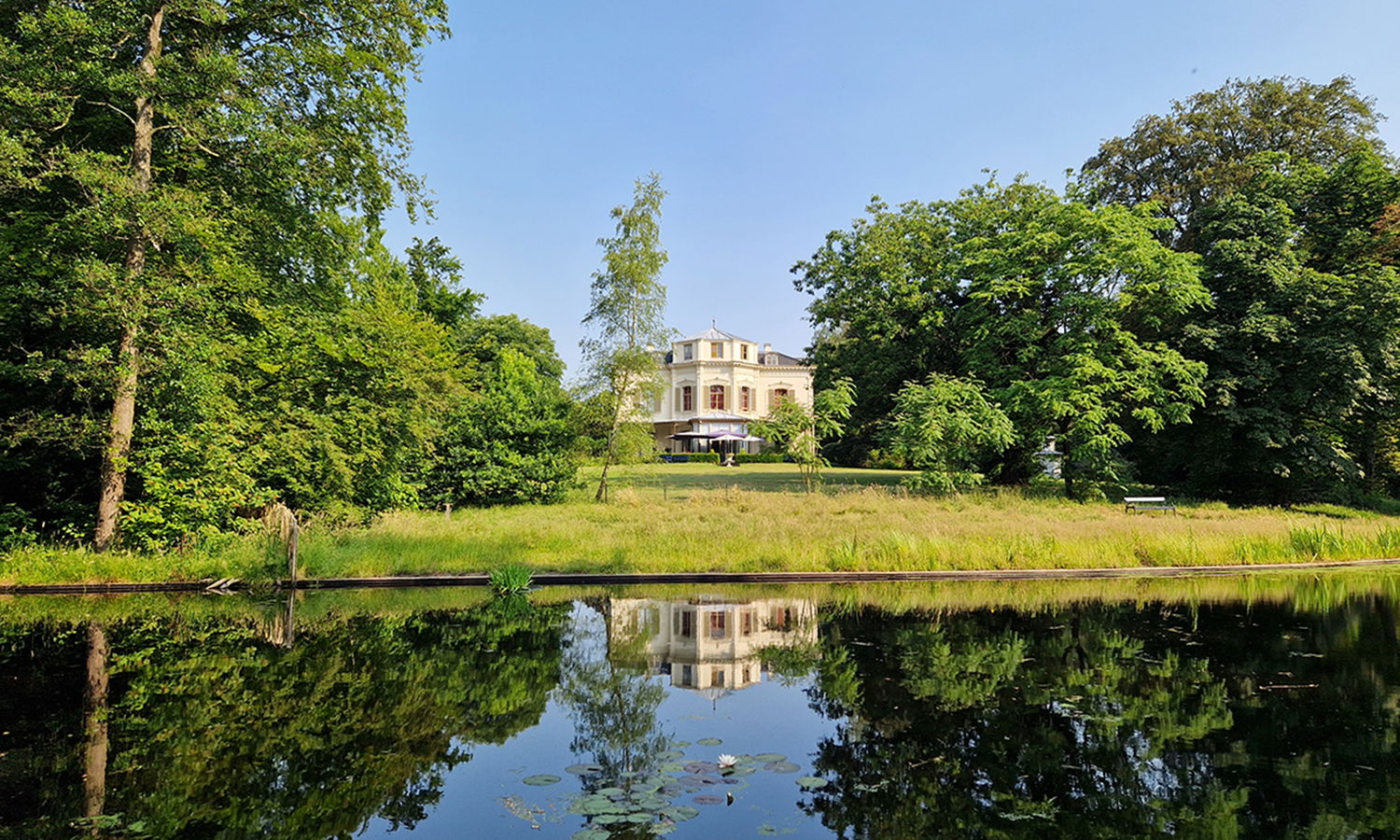
Look how beautiful it looks and how beautifully the house reflects in the pond with water lilies.
The country estate was separated from his country estate Hoog Beek en Royen in 1850 by Albert Voombergh (1793-1851), head of the Amsterdam banking house Ketwich en Voombergh, and donated from her inheritance to daughter Aletta Cornelia Anna Voombergh (1828-1913) and Matthieu Christiaan Hendrik Ridder Pauw van Wieldrecht (1816-1895) at their wedding on 12 October 1855. The name Pavia is derived from the surname Pauw, in Latin Pavo. How rich that man must have been for such a wedding gift. In 1913 the grounds of the country estate were purchased by the municipality of Zeist, but the house remained in the Pauw van Wieldrecht family until 1936. By merging it with the forest area of Hoog Beek en Royen, an adjoining walking area of 209 ha with 5.5 km of forest paths was created. This area is bordered by the Laan van Beek en Royen, the Arnhemse Bovenweg, the Prinses Beatrixlaan and the Zeister forest.
To the right you walk towards the deer park, Bison Park and the Jagershuis, but I walk left around the winding pond towards the Laan van Beek en Royen. From 1926-1939 there were bison in this park. The bison couple Jupiter (1905) & Juno (1924) ensured many descendants until their extinction in 1939.
The pond is full of coots, wild ducks, moorhens and of course a heron, but what is also very special is that there are a number of water turtles in it. Fortunately, these were released back together with the fish after renovation of the pond by Het Utrechts Landschap.
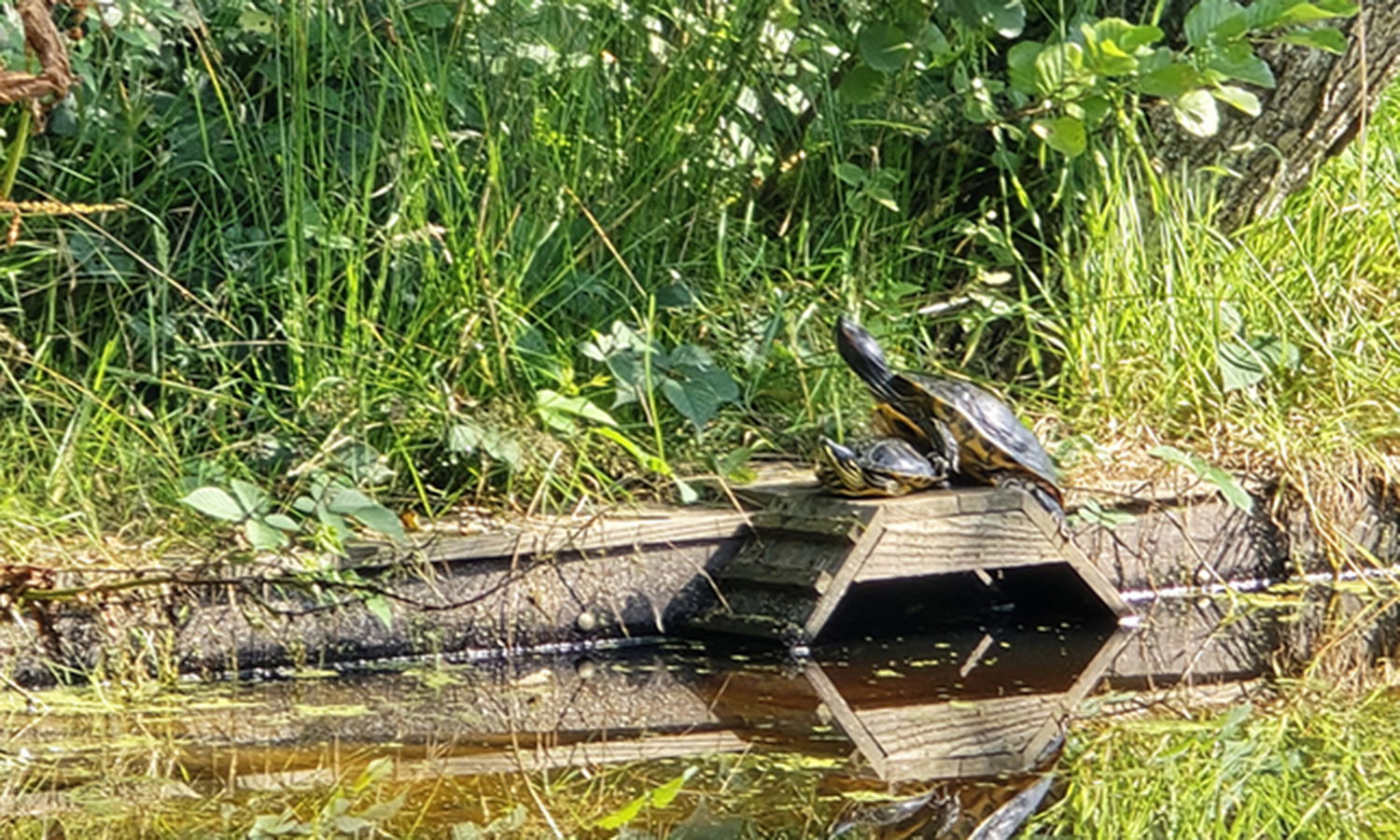
Look at them there on the other side, the two of them sunbathing together. As I walk left around the pond over the original cast iron bridge I enjoy the silence and bird sounds and think of times gone by when I used to walk here as a youngster with friends and my girl. The planting of the forest dates from around 1825 and largely from the time before it was built. The path ends at the access road from the Arnhemse Bovenweg and is an extension of the Kippenlaantje (origin of the name unknown) that starts on the other side of Buitenplaats Hoog Beek en Royen. You can see the oaks of this lane continue towards the deer park. You walk straight ahead via the 2e Hogeweg into the village and turn right and you will come out in front of the house. On the street I hear people say that they are going to the city or have been there, but Zeist with everything a city has, fortunately remains a village with almost 67,000 inhabitants.
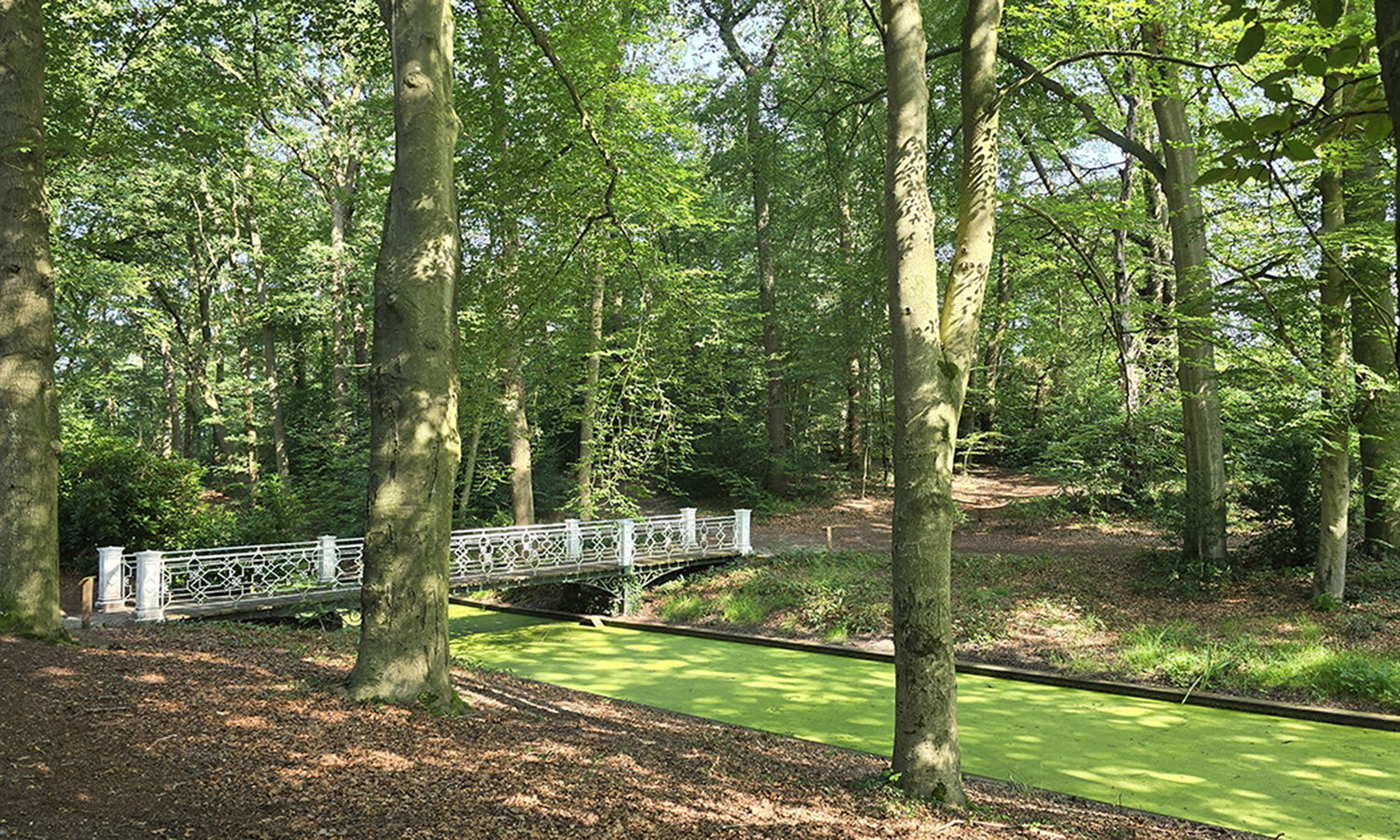
After the death in 1936 of Adriana Johanna Schimmelpenninck - Pauw van Wieldrecht, cutlery manufacturer Johan-nes Albertus (Albert) Gerritsen bought the house in 1937. During the war years, the Germans requisitioned the house and in 1947 it was sold and put into use as a girls' boarding school. When I still worked at the Kroondruk printing company next to the Schat bakery on the 2e Hogeweg (I can still smell that delicious bread smell every day), I walked every day from the Charlotte de Bourbonlaan along the back of the Pavia house in the hope of catching a glimpse of all the beauty that the girls' boarding school that was located there at the time hid. In vain, the ladies were kept out of sight by the Christian association.
From 1976 onwards the house changed owners several times and was used to accommodate political refugees from Chile and Argentina, rent out apartments, broadcasts by Regional Broadcaster Radio Utrecht and since 2004 it has been in use as a private care centre “Hetbehoud huis” where you can spend your old age from € 4,750 per month. It is great that the building and surroundings have been preserved.
When I arrive at the house I take a photo with Siena & Giulia on it, as I do for all country houses. They sit patiently until I am finished and we walk on. To the left of the house is a white high wooden dovecote and I still remember that there was a tennis court and volleyball field next to it. Opposite the house on the other side of the lawn on the side of the Laan van Beek en Royen is an enormous red beech with a variety of trees and rhododendrons on both sides.
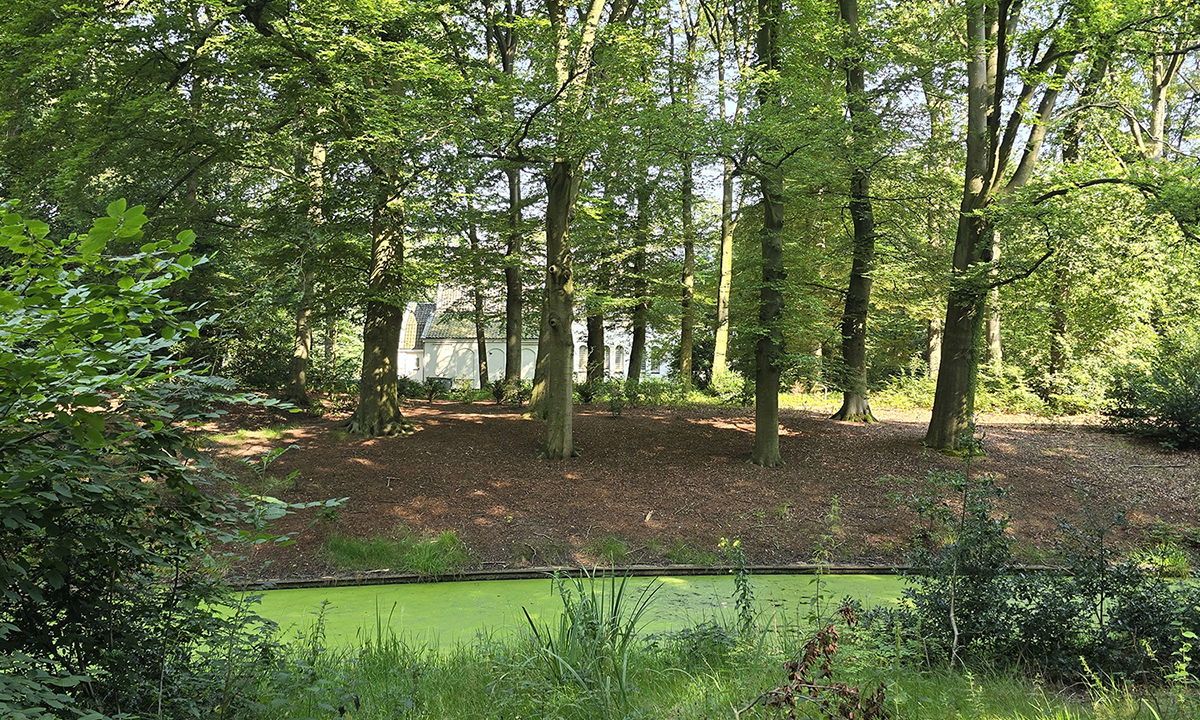
I walk on and the dogs run after each other towards the Forest chapel. Here I find the coffee-drinking forest ranger Joris and Jan-Willem on a fallen tree. Both employed by Het Utrechts Landschap. Jan-Willem maintains the forests in this part of Zeist with volunteers. Giulia runs up to Jan-Willem and lets herself be cuddled, but Sie-na stays at a distance, she is not really into cuddling strangers. Both gentlemen tell me that they close off elephant paths (non-official paths) with new planting, dead branches and wooden trunks. With a successful and pleasant day, I whistle the dogs next to me and continue my walk.
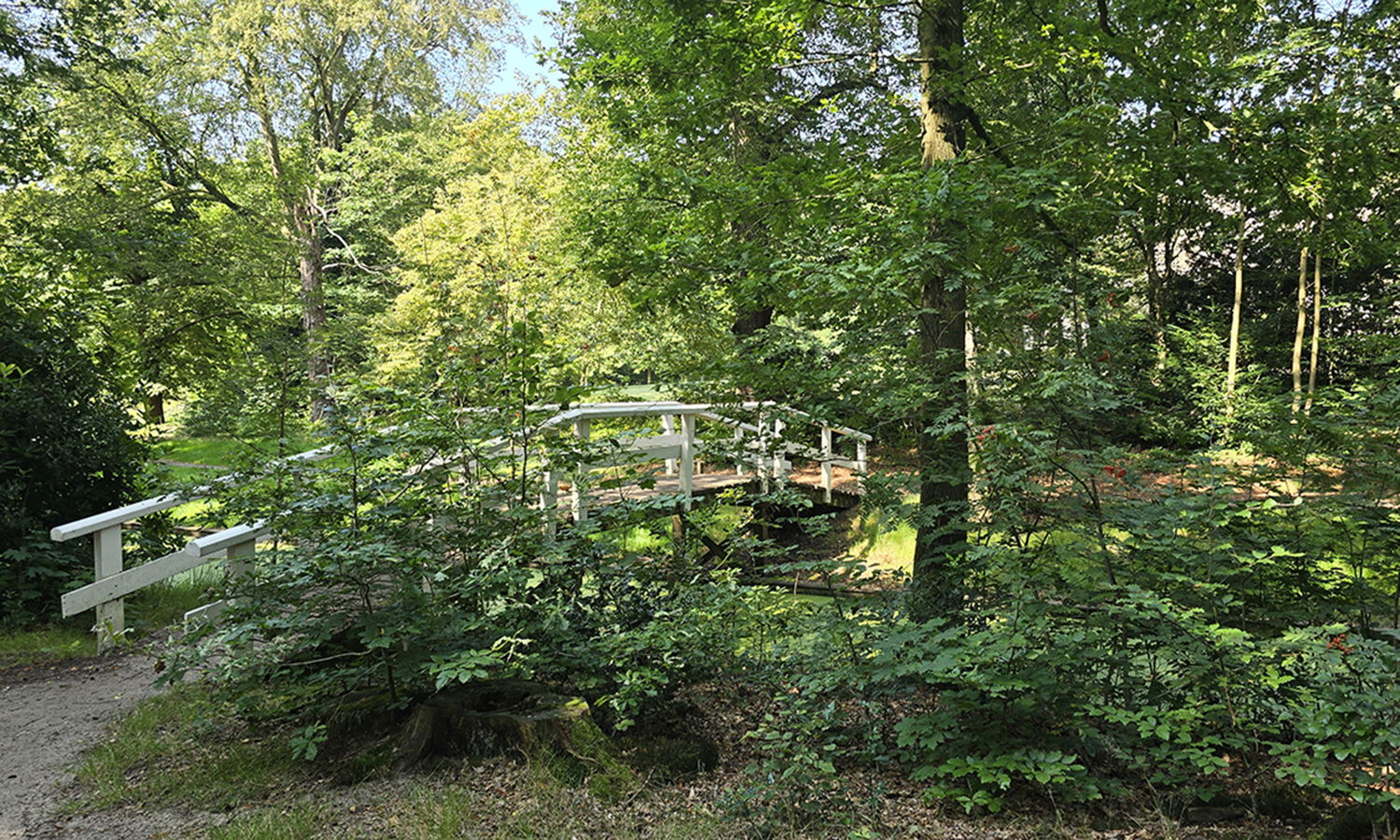
The Forest chapel on the Laan van Beek en Royen was originally the coach house and was sold in 1946 to the Church Society of the Dutch Reformed Church of Zeist, who renamed it Boskapel. During the restoration, the stable doors were removed and a kind of porch was built as an entrance to the church. Since 1979, the Boskapelwerkgemeenschap Foundation has been in it, with the artists' association 'De Toets' in between, and since 1986, the Royal Harmony Society Oefening Baart Kunst (OBK) has been the owner.
After the Forest chapel, I walk to the oak lane that runs left towards the deer park and turn right to walk across the wooden bridge behind the garden of the house on the other side of the winding pond. There is a bench here where you can enjoy all the beauty around you.
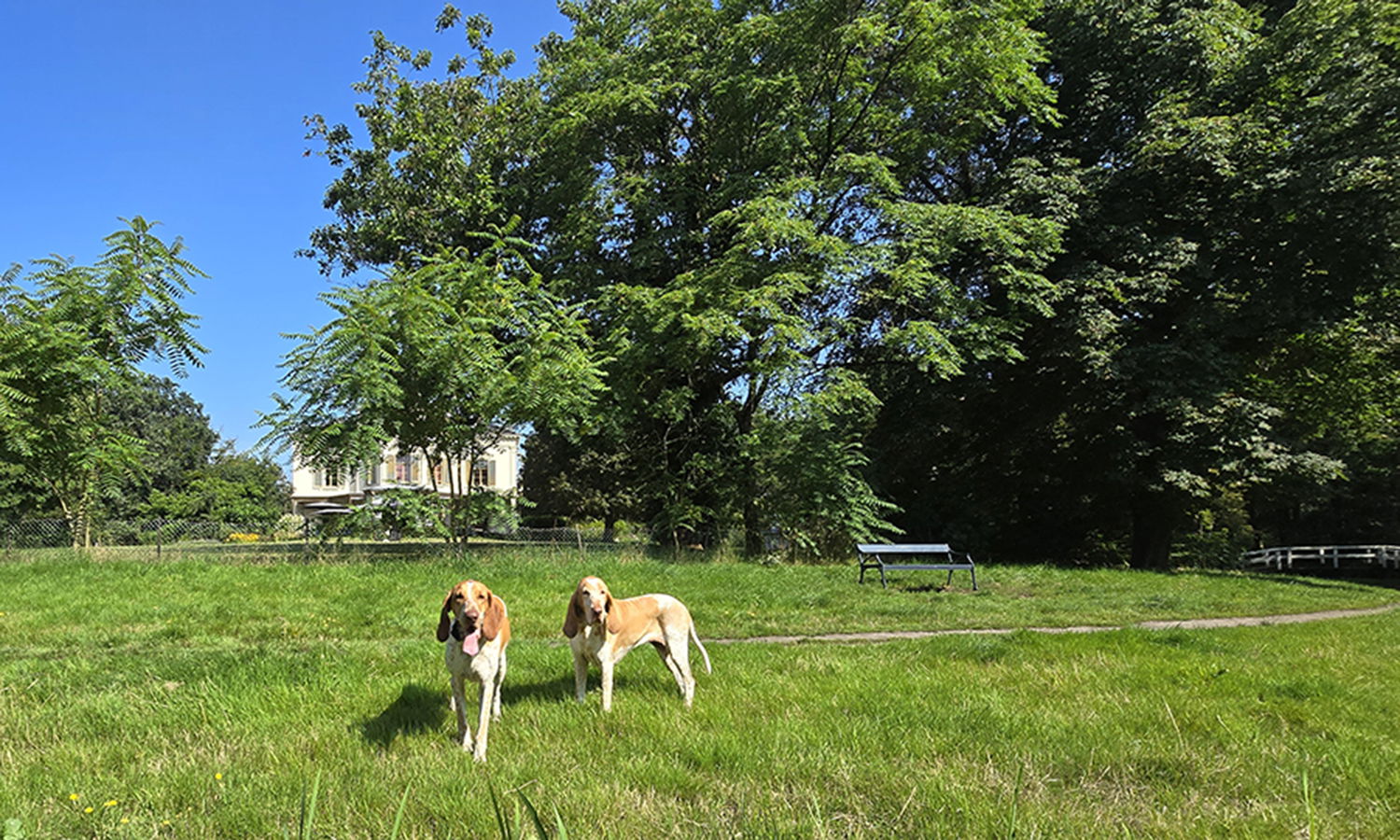
Then I walk further to the flat bridge and see the back of the stately white house at Arnhemse Bovenweg 1A where Mr and Mrs Plaisier used to live. The driveway ran past the house where his grey Mercedes 450 SLC was parked right in front of the house in a garden that was always neat and tidy and was maintained weekly by a gardener. Mr Plaisier always walked neatly in a suit with a long coat and a hat that he took off when we greeted each other. In addition, as a second home on the Arnhemse Bovenweg 1B and left before the Prinses Beatrixlaan, general practitioner Dr. Sams-on had a practice and also lived there with his family.
Via the field behind Pavia I walk towards Prinses Beatrixlaan and look back once more at this special house with a long and rich past. On the left of this avenue I pass a beautiful thatched villa with the text “Inter Arbores” on the facade (Latin for between the trees) where the Korstanje family of the installation company of the same name used to live, with the house “Berkenhoeve” of the Van der Ree family with the administration office at home diagonally opposite. We have been good friends with one of the daughters and her husband for many years, although we did not know each other at that time. Coincidence does not exist?

Behind that enormous 12-meter high acacia (Robinia pseudoacacia) I see the dormer window behind which my bedroom was located and from which I had a magnificent view of the forest and avenues. Through wide lanes I walk from our old neighbourhood Hoge Dennen back to our apartment on Prinses Marijkelaan in the Kerckebosch neighbourhood.
In the gallery of the website you can find many more beautiful photos.
How beautiful Zeist is and how lucky we are to live here.
Until the next walk around Zeist Castle, Arnie Della Rosa
You can read my walking stories but also many columns by other Zeister columnists on https://www.zeistermagazine.nl
Brief overview of country estate Pavia
Address: Laan van Beek en Royen 45